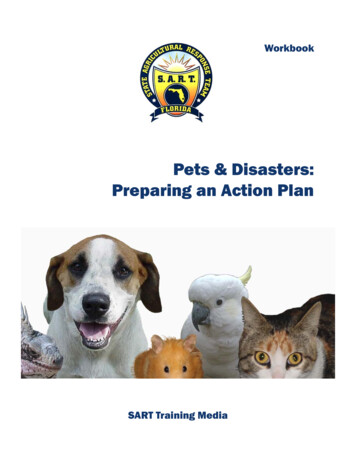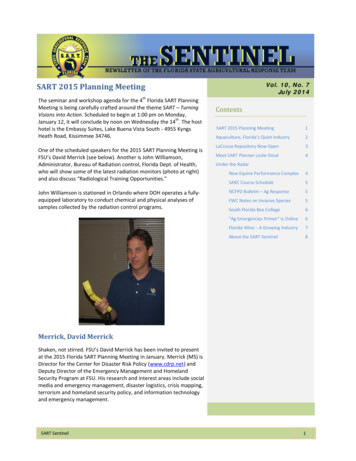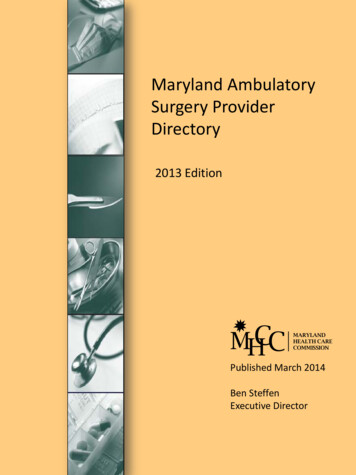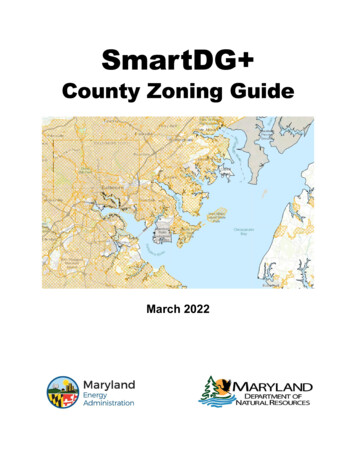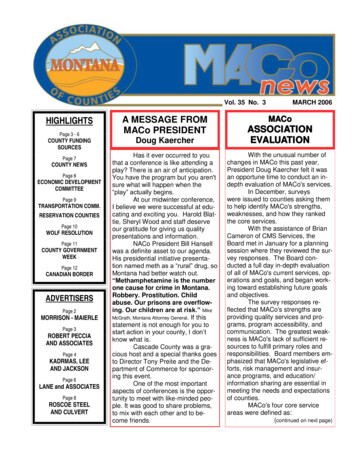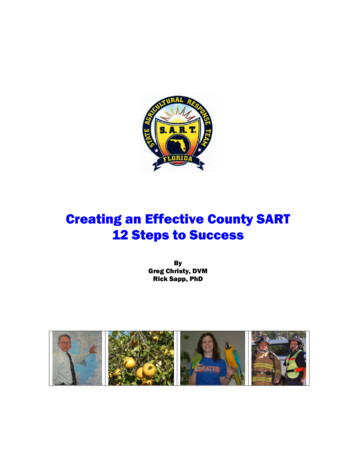
Transcription
Creating an Effective County SART12 Steps to SuccessByGreg Christy, DVMRick Sapp, PhD
2
Creating an Effective County SART12 Steps to Success3
Creating an Effective County SART12 Steps to Success May 2007Florida Department of Agriculture & Consumer Services, Department of AnimalIndustry, Mayo Building, Room 333B, 407 S. Calhoun St., Tallahassee, FL 323990800 (850) 410-0902 www.doacs.state.fl.us/ai/ or www.flsart.orgPhoto Credits (page): all photos by Rick Sapp except – NOAA (11), IFAS/UF (17, 29),Logo (29 – “Educate To Detect” Courtesy SPDN)To download Florida SART Training Media, visit the Florida SART Internet site atwww.flsart.org.4
TABLE OF CONTENTSPart I: INTRODUCTION AND NEEDPurposeDefinitionIntroductionWhat is SART?What is the SART mission?What are SART’s goals?What is a County SART?What does a County SART do?Training - Outreach – NetworkingWhat evidence exists of the need for a County SART?Who should form a County SART?To begin .7778899910121414Part II: 12 STEPS TO AN EFFECTIVE COUNTY SART1. Operate as a multi-agency coordinating group2. Establish regular meetings with agendas3. Work with the county ESF-17 coordinator4. Review and update your county ESF-17 plana. Analyze the threatsb. Perform an animal and agricultural censusc. Prepare a support profiled. Develop a concept of operationse. Perform follow-up analysisf. Immediately implement what you learn5. Develop an active outreach and recruitment effort6. Promote awareness of your County SART7. Support and utilize the Florida SART website8. Provide training for County SART members9. Become NIMS compliant10. Develop a regional context and contacts11. Identify and obtain ESF-17 equipment and supplies12. Take time to enjoy the process1717181920PART III: APPENDICESAppendix 1: County SART ESF-17 Plan TemplateAppendix 2: NIMS On-Line Courses of Particular InterestAppendix 3: Florida’s Regional Task ForcesAppendix 4: Florida Emergency Management Functions383838404152528293032343536
6
PART I: INTRODUCTION AND NEEDPurposeTo encourage the development of County SART programs in Florida as multi-agencycoordination (MAC) groups, and to open a dialogue about 12 fundamental issues thataffect the success of County SARTs once the initial steps have been taken.DefinitionThe definition of a multi-agency coordination group varies slightly betweenjurisdiction and general purpose. The essence of your role as a County SART team led(preferably) by the county ESF-17 coordinator, a local chair and an Advisory Boardand acting within the scope of animal and agricultural issues can be gleaned fromthe following two sets of direction. According to the Federal Emergency Management Agency in the Departmentof Homeland Security, “A multi-agency coordination system (such as yourCounty SART) is a combination offacilities, equipment, personnel,procedures and communicationsintegrated into a common system withresponsibility for coordinating andsupporting domestic incidentmanagement activities. The primaryfunctions are to support incidentmanagement policies and priorities,facilitate logistics support and resourcetracking, inform resource allocationdecisions using incident managementpriorities, coordinate incident management related information, andcoordinate interagency and intergovernmental issues regarding incidentmanagement policies, priorities and strategies.” (FEMA Independent StudyProgram IS-701) From the Florida Department of Law Enforcement’s perspective, “The missionof a multi-agency coordination group is to function as a coordination entity tosupport local Incident Command in coordination with the local EmergencyOperations Center(s) and the state EOC, by assisting with the deployment ofresources needed to prevent, prepare for, or respond to an event involving7
weapons of mass destruction (WMD) and to prevent or mitigate additionalattacks. A MAC group is comprised of discipline leadership, usually consistingof Law Enforcement, Fire Rescue, Emergency Management andHealth/Medical representation.” (“Making Florida Safer: 2006 DomesticSecurity Annual Report” Florida Domestic Security Oversight Council, FloridaDepartment of Emergency Management)IntroductionA disaster or threatening situation in the animal and agricultural sectors involves theresources of government, private profit and non-profit organizations, and affectedindividuals at all levels: federal, state, regional and local. The ultimate point ofresource application however is always local: the intersection where the hurricaneknocks over the power pole and transformer, the playground where the dead birdsare discovered, the field contaminated with an unusual white dust. Thus, theformation of SART organizations at the local level is vital, because the intimateawareness of and understanding of local circumstances is finest at the local level.Following the lead of the federal government, the State of Florida has organized itsemergency response by function (see Appendix 4) and a county’s emergencymanagement mimics this structure.Within this document, the “local level”“We want to draw attention to the fact that ESF-17 isis defined as a county because ina very diverse group,” says Tom Holt, DVM, FloridaFlorida, the county is the basicState Veterinarian. “And it is this diversity that bothconstitutional entity. Still, there is nogives us strength and creates opportunities to learn toreason that cities, towns or evenwork together effectively, to bring a lot ofneighborhoods – or groups of citizensperspectives and points of view to the SART table.”such as area cattlemen or a town’scat owners, for that matter – cannotinitiate a SART program that integrates creatively and effectively into their countysupport structure. Lower level SART organizations could in fact use the same formatand organizational principles developed in this handbook and the earlier, June 2006handbook, Creating A County SART.What is SART? SART is a multi-agency coordination group consisting of governmental andprivate entities dedicated to all-hazard preparedness, planning, response andrecovery for the animal and agricultural sectors in the state of Florida.SART operates at the local level through county SART organizations.8
SART utilizes the skills and resources of many agencies, organizations andindividuals with its multi-agency coordination group structure.SART supports the county, regional and state emergency management effortsand incident management teams.What is the SART mission?SART is designed to empower Floridians throughtraining and resource coordination to enhanceall-hazard disaster planning and response foranimals and agriculture.What are SART’s goals? To promote the active engagement ofeach county ESF coordinator who isresponsible for animal and agriculturalissues.To provide assistance in the development and writing of county ESF-17 plans.To promote the establishment of a county SART which will work as a multiagency coordination group to support emergency management and incidentmanagement teams.To provide training for all SART and animal and agricultural personnel.To identify the resources available for an emergency or disaster.To work toward compliance with the National Incident Management System(NIMS).What is a County SART?A county-level State Agricultural Response Team or SART is a group of individualsfrom a specific county that prepares for, responds to and aids in recovery from ananimal or agricultural emergency or disaster. A county SART’s work improves theplanning, response and recovery process. (Although the words “state” and“response” appear in the SART name, a County SART is not necessarily a responseteam. Some SART members will almost certainly be first responders while others willnot. And a County SART will work within it’s county structure, coordinating with butnot accountable to the state of Florida.)9
SART members are drawn from county agencies and from organizations that play arole in the animal and agricultural community. A SART group may also – indeed, itshould –include concerned individual citizen volunteers. Through the County ESF-17coordinator, County SART members provide critical support to an incidentmanagement team and other first responders, assist victims (within the scope oftheir expertise and training) andcollect information that allows timelyAccording to Shawn Crocker, president of thedisaster relief to reach those who mayHillsborough County Farm Bureau, “A partnership inbe in critical need.these efforts will make our communities moreefficient in handling animal and agriculturalemergencies.” (www.chaart.org/files/workshops.html)As a multi-agency coordination group(MAC), the county SART is essentiallya coordinating entity for local animaland agricultural disaster issues: helping identify priorities that guide incident management objectives. providing and/or identifying resources for an incident. integrating incident communications and information. Assisting with interagency decision coordination.(An excellent example of County SART organization can be found at www.chaart.org,the web site of the Hillsborough County, Florida SART team, the County ofHillsborough Animal and Agricultural Response Team or CHAART. The leaders ofCHAART have taken the additional step of registering with the Internal RevenueService as a non-profit 501-(C)-3 Corporation.)What does a County SART do?A County SART meets regularly, perhaps monthly or bimonthly. The primary purposeof a County SART meeting is todevelop a network that can effectively“If you are going to change the outcome [of a disasterplan for, respond to and assist in thesituation], you have to be in fast. Do not be afraid ofrecovery from disasters affectingmaking the wrong decision. If you wait until all theanimals and agriculture.assessments and evaluations are done, you’re alreadywrong. Respond like the situation is bad and if it isn’t,then ratchet your response down. The first 72 hoursare critical.”William “Craig” Fugate, DirectorFlorida Division of Emergency ManagementPresentation to Florida SART Conference, May, 200710To accomplish this purpose, membersperform or develop a county animaland agriculture risk assessment plan;share information about disasterrelated activities from within theirorganizations; disseminate and reviewtraining materials; prepare for or
debrief from incident activation; and/or update the county ESF-17 plans incooperation with county emergency management staff.In an emergency, the County SART responds as a key resource to the county’s ESF17 coordinator. Some SART members may be called upon to assist the coordinator atthe county emergency operation center (EOC)or may be requested to report to and supportthe ESF-17 response. Other members willwork with their respective organizations oragencies while maintaining contact with thecounty SART network.County SART members may be asked to assistduring such events as a hurricane or plant oranimal disease outbreak.Although the aftermath of an emergencysituation or a disaster can linger for manyyears and can permanently change a community, any community-wide hazardoussituation will happen relatively infrequently and, however severe, will be of relativelybrief duration. Thus the primary on-going activities for County SART members will beparticipating in training and educational programs, and outreach and networkingactivities. Training may take place at local meetings, state conferences or workshops.Indeed, many of the Florida SART training modules are designed for self-study.Training will almost certainly beprovided at the Florida State SARTconference and at associatedorganizational meetings andactivities. The various governmentalor organizational-led simulations thatinvolve a community’s animal andagricultural sectors will provideadditional training. Relevant trainingmaterials are always prepared forworkshops and conferences, andshould be widely shared within theCounty SART team. Outreach involves educating thecommunity about the SART mission11
and recruiting agencies and organizations. Recruitment may begin with suchactivities as conducting community workshops on preparing pet disaster kits,disseminating pet-friendly shelter information, demonstrating sprayapplications for pest-infected nursery stock or staffing a SART booth atcommunity events, such as county fairs or hurricane preparednessexpositions. Networking will be an important component of fulfilling your County SART’sgoals. Mission-helpful contacts will be made while staffing display booths,attending training workshops, at the annual SART conference and during ESF17 activation for an emergency. Networking may even include developingmutual aid agreements with other counties or organizations, and sharinginformation about needs, resources and perceived threat horizons.What evidence exists of the need for a County SART?Here are examples of situations in which an effective county SART program couldhave benefited residents in the animal and agricultural sectors:Hurricane Andrew, August 24, 1992: This Category 4 hurricane swept ashore inDade County w) and resultedin an estimated 25.5 billion indamage in Florida alone and another“One of the important things with volunteers is to 1 billion damage in Louisiana. Ahave regular meetings and to have interesting andquarter-million people were leftdifferent training opportunities,” says Arlene Ungar, ahomeless by its winds, tidal surge andFlorida SART member who resides in Phoenix,tornadoes. Agricultural losses wereArizona. “The interesting part of volunteering –estimatedat more than 1.04 billion.especially with animals – is to have different training“The slow response of federal aid tosuch as with birds and wildlife and horses [and otherstorm victims in southern Florida ledexotic pets]. There are a lot of people out there whoDade County emergency managementwill volunteer, you just have to look for them.”director Kate Hale to famouslyexclaim at a nationally televised newsconference, ‘Where in the hell is the cavalry on this one? They keep saying we'regoing to get supplies. For God's sake, where are they?’” (as quoted inhttp://en.wikipedia.org/wiki/Hurricane Andrew)“As this year's hurricane season approaches, the images of [Hurricane] Katrinaare still with us. The German shepherd that survived in his home, waiting for hisowners, 71 days starving and alone. The family who themselves went without food12
and water as they hid with their dogs and newborn pups and the sad memory ofthousands more that died, their stories untold.”We placed ourselves at great personal risk to save those that we could as wepromised ourselves that this could never happen again. We lobbied, and won theright to evacuate pets both with Federal and State laws. But the hardest part is nowup to us – to do what we promised. To respond when a hurricane threatens the Stateof Louisiana, and to evacuate pets alongside their owners. This is now possiblethrough the tireless efforts of the Louisiana State Animal Response Team.” (fromMuttShack Animal Rescue, http://www.muttshack.org/)Christopher Shays, a U.S. Republican Representative from Connecticut and,with Tom Lantos, A U.S. Democratic Representative from California and co-chairmanof the Congressional Friends of Animals Caucus, has said that estimates of animalsthat died or were left without shelter as a result of Hurricane Katrina ranged as highas 600,000. He added that the lack of pet rescue plans also put many pet owners indanger. "When asked to choose betweenabandoning their pets or their personalsafety,” he said, “many pet owners chose torisk their lives."It is not only such enormous naturaldisasters as hurricanes, however, that impelthe formation of county SART teams. Forinstance, Florida has the highest number ofthunderstorm days (with associatedlightning strikes and straight-line winds) peryear of any state in the U.S. And comparedto other states, Florida ranks number four infrequency of tornadoes. In addition, theFlorida peninsula, which points invitinglyfrom the temperate North American into thetropical zone of the Caribbean, now hoststhousands of invasive, non-native anddestructive plant, animal and insectspecies.Florida, of course, is affected byinnumerable other factors and the fate of itsanimals and agriculture cannot beseparated from the wider U.S. or worldenvironmental systems. The spinach contaminated with potentially deadly E. coli13
bacteria in 2006 was grown in California, but at least one Floridian died as a result.At least two victims of the 9-1-1 terrorist attacks called Florida home. The EHV-1incident that took place in December 2006 began with horses imported from Europethrough New York and resulted in the death of six horses in Florida. And this noteappeared on March 27, 2007 on www.CNN.com: “At least 471 cases of pet kidneyfailure have been reported in the 10 days since a nationwide recall of dog and catfood and about a fifth of those pets have died, a veterinarians' information servicesaid Tuesday.”“To prevent, prepare for, respond to, and recoverfrom terrorist attacks, major disasters, and otheremergencies, the United States Government shallestablish a single, comprehensive approach todomestic incident management.”Homeland Security Presidential Directive 5Who should form a County SART?A County SART is a local levelorganization that replicates in detailthe function of the Florida StateAgricultural Response Team. It helpsorganize and coordinate resources tobetter prepare for, respond to and aidin the recovery from disasters that affect animals and agriculture.Every Florida county could benefit from a cohesive and functioning SART program,because each county in the Sunshine State has an animal and agricultural sectorthat may be affected by a variety of emergencies. As is said about the next significantCalifornia earthquake, “It is not a matter of if, but when.”While the matrix of animal and agricultural need may be quite different for eachcounty – Miami-Dade having a very different natural and demographic profile, forinstance, than Nassau or Leon – each has individual concerns that must beaddressed prior to an emergency or disaster, whether natural or man-made,predictable or spontaneous. It is only in effective preparation and practice that wecan ensure a continuation and even an improvement of our way of life.To begin .This handbook seeks to begin at the point the June 2006 handbook Creating ACounty SART ends. It takes for granted that your county now has the nucleus of aSART organization for animal and agriculture issues. It assumes that your CountySART has a designated chair and a functioning Advisory Board, as well as the activecooperation – or at least the awareness – of the county ESF-17 coordinator. Now istime to roll up your sleeves and make something wonderful happen for yourcommunity, to share the vision.14
Notes15
16
PART II: 12 STEPS TO AN EFFECTIVE COUNTY SARTIn the following dozen easy steps, any county in Florida can develop the frameworkfor an effective local multi-agency coordinating group, a County SART team operatingunder the auspices of the county ESF-17 coordinator. Functioning with the directionof a small, but committed Advisory Board that represents all sectors of a county’sanimal and agricultural community, your County SART becomes a vital member of theoverall ESF-17 efforts.STEP 1: Operate your County SART as a multi-agency coordinating groupYour County SART will operate as a multi-agency coordinating group, a MAC. Althoughit should have member representatives from first response agencies, even asmembers of the Advisory Board, SART itself is not designed to be a hands-onresponse unit in an animal or agricultural emergency.According to FEMA’s IS-701, a MAC is acombination of facilities, equipment,personnel, procedures and communicationsintegrated into a common system – and withinthe federal guidelines, there are numerouslevels. As a local MAC, your County SART willbe responsible for coordinating andsupporting domestic incident managementactivities in the animal and agriculture areas.Your primary functions are defined in thismanner: to support incident management policies and priorities,facilitate logistics support and resource tracking,inform resource allocation decisions using incident management priorities,coordinate incident management related information andcoordinate interagency and intergovernmental issues regarding incidentmanagement policies, priorities, and strategies.Your County SART is therefore designed to be aware of and in communication withexperts, trained responders and resources within your county, your region andultimately (because networking is an overall SART priority) around the state, for –theoretically – any hazardous animal or agricultural situation. In the simplest terms,your County SART will assist the ESF-17 function by communicating, tracking andcoordinating.17
STEP 2: Establish regular meetings with agendasYour County SART program is constituted with an Advisory Board that is committed toeffective implementation of plans that will safeguard your county’s animal andagriculture sectors in an emergency. You have probably developed a County SARTMember Application and circulated itto prospective stakeholders.How can a SART make a positive impact?According to Liz Wang, Executive Director of theTexas State Animal Resource Team in Austin, “ bymaking sure they get full support and participationfrom their EOC, both the director and ESF-17coordinator. If they don’t organize in cooperation withtheir EOC director, their work isn’t going to matter.They’ll just be spinning their wheels.”(A model Member Application isincluded in the first SART handbookCreating A County SART, but you maychoose to develop an application andmembership procedure that istailored to your county’s specificneeds. A paper form (as well as anelectronic form) is important,however, even if people have signed up as SART members on the Florida SART website at www.flsart.org. A local level contact sheet allows the Advisory Board to build amembership roster and to develop contact lists for various animal and agriculturalsituations.)Now it is also important to have a published schedule, a specific date, time andlocation for SART meetings, and a firm agenda. Choose a central location for theseinitial meetings. Good possibilities are the county emergency operations center, thecounty USDA-Farm Service Agency, the U.F. Cooperative Extension Service office oreven a public library meeting room. The meeting location should have the capabilityto access the Internet and to host training classes. Be sure to have someone takeand circulate notes of the proceedings, the issues discussed and action itemsdecided.Our Santa Rosa County SART1. Modeled to operate as a county level SART2. Combines the skill and resources of manyagencies, organizations and individuals like NRCS,FSA, Cooperative Extension Service, county levelagencies and government3. Supports the county, regional and stateemergency efforts4. Provides early notification of damage to theagricultural communityTravis Kelley, County Executive DirectorUSDA, FSA18Your Advisory Committee will developmeeting specifics, but a regularlyscheduled meeting with a publishedagenda and at least one new andnotable reason to attend each timewill solidify your diverse county groupas a work-together team. “New andnotable reasons” could be a meetingwith the county ESF-17 coordinator(who should, in any case, be amember of the Advisory Board); apresentation by a local reptile experton how to recognize the exotic pets
that are most common in the area; or a review of a Florida SART training module.The county emergency management director’s attendance is important at an earlyCounty SART meeting where community benchmarking and initial review of the ESF17 plans will occur. Now that counties have mandated responsibilities to provide forpet evacuation and safety, there should be additional reasons why a county directorwill appreciate the assistance of a County SART.STEP 3: Work closely with the countyESF-17 coordinatorBy now your County SART has a firmdirection with a committed and functioningAdvisory Board. And, encouragingly, thecounty’s emergency management responseteam is informed and, at whatever level younegotiate or they deem appropriate, isinvolved in the SART effort.It is time to work closely with your ESF-17 coordinator – whom you already know andwho presumably concurs with the idea that a County SART will make their job botheasier and more productive – to review county emergency management plans. (If youhave not already done so, this is the time to become acquainted with the physicallayout and capabilities of your county emergency operations center.)It is up to your group now to determine, to be attentive to, and to make suggestionsabout how the County SART can assist with county ESF-17 efforts. This is the pointthat the work to bring many different agendas and points of view into synchronicitybegins to pay dividends for the animal andagricultural sectors of your county.It is important that every stakeholder havea voice, that your effort is Inclusive ratherthan Exclusive, because plant and animalissues – indeed even the difference inissues between household pets and largeranimals such as horses and goats – ispronounced.19
STEP 4: Review and update your county ESF-17 planThe ESF-17 animal and agricultural effort is part of your county’s emergencyoperations plan. With the approval and support of your county emergencymanagement director and the ESF-17 coordinator, who will either direct or be a partof the effort, your County SART will “brainstorm” the plan: take it apart and analyzeeach section, then put it back together again in accordance with state Division ofEmergency Management standards. Often, the plan you begin with will seem foreignand bureaucratic. The County SART’s job will be to understand it as an operationalguide and to flesh it out for animals and the agricultural sector, thus bringing it to life.A thorough ESF-17 plan for your county should take into account each element of theanimal and agricultural sector, from horses to geckos, ornamental nursery plants tofield crops. Typically, ESF-17 will be one of the last annexes in the plan, but followingthe pet disaster that resulted from Hurricane Katrina in 2005 (see page 11), the ESF17 function has gained considerable publicity and public support.Remember, also, that a plan is only a guidance document and not an SOP orstandard operational procedure. YourCounty SART is a volunteer“Because we were so hard hit in 2004-05 with Katrina organization, a multi-agencycoordinating group, not a line functionand the other hurricanes, we have had a tendency toand its members in Florida are notfocus on natural disasters and they will never goaway,” says Joan Dusky, PhD, Associate Dean forfirst responders. Even thoughAgricultural Extension Programs, IFAS, “So there isparticular members, the Sheriff’salways going to be a need to be prepared for them.Department, for instance, may have“Even more insidious, however, alert systems need todetailed first response emergencybe in place to deal with insects and diseases that move tasks, most members will not havein unexpectedly with the wind or hijack into the state.this kind of job description. MostWe have so many new insects here that we need to beCounty SART members will havevigilant and prepared to eradicate or manage them.”agency or organizational affiliationswith response guidelines that dovetailinto your County SART plans and efforts and are present to coordinate, inform andnetwork.Here is a template that may help develop a good introductory plan for your county. (Itis reprinted in outline form as Appendix 1.)A. Analyze the possible threats.This is also called performing a “risk assessment.” Although every county willbe slightly different in its final document format, the threat matrix will firstneed to be understood.20
a. Acts of nature such as hurricanes, tornadoes, out-of-control fires,extensive drought or the opposite, extensive flooding. Does your countyhave a history of destructive fires? Is it outside the regular andpredictable path of hurricanes?b. Intentional or unintentional human acts. Whether accidental or an actof terrorism, such an event cannot be predicted in the same manneras the year’s hurricane season or cycles of sun spot activity or theappearance of migratory birds that may spread avian influenza or WestNile virus. For planning purposes, unintentional human acts happenrandomly in time – tonight, tomorrow or perhaps never – whereasintentional acts (setting wildfires or contaminating food) are designedfor maximum impact and exposure, and can sometimes be anticipated.This of course makes the planning, response and recovery task moreof a challenge and all that more necessary.B. Perform a county ESF-17 animal andagricultural census.It is not possible to know the exactnumber and type of pets in thecounty and even experts willdisagree about the number of largeranimals such as horses or cows.Neither is it possible to knowprecisely, for instance, how manyacres of soybeans have beenplanted and might be affected bysome new variety of soybean rustblown ashore with the nexthurricane. These things can beestimated fairly closely, however,and resources are available throughthe various members, agencies andorganizations that have joined yourCounty SART. In addition, the countywill maintain a listing of dangerousdogs, wildlife rescue facilities or exhibitions, and pet dealers licensed tohandle and sell venomous reptiles. For pets, a reasonable rule-of-thumb is toestimate one pet per two residents.Information about breeding colonies of invasive exotics should be included inboth the animal and agricultural census. This information can easily be21
accessed through members who are part of the statewide, UF/IFAS-dir
Part II: 12 STEPS TO AN EFFECTIVE COUNTY SART 17 1. Operate as a multi-agency coordinating group 17 2. Establish regular meetings with agendas 18 3. Work with the county ESF-17 coordinator 19 . weapons of mass destruction (WMD) and to prevent or mitigate additional attacks. A MAC group is c
